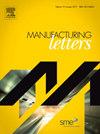Experimental identification of yield surface for additively manufactured stainless steel 316L under tension–compression-torsion conditions considering its printing orientation
IF 1.9
Q3 ENGINEERING, MANUFACTURING
引用次数: 0
Abstract
Stainless steel 316L tubes and bars were additively manufactured (AM) by using the Laser Powder Bed Fusion Melting (LPBF-M) method in three orientations. As-built specimens were then machined and the initial yield surface was determined for three printing orientations based on the yield stress definition for 0.005 % plastic offset strain. The as-received, wrought material was additionally tested using the same tension–compression-torsion conditions to compare the mechanical behaviour of AM and wrought SS316L. The sizes of yield surfaces elaborated for LPBF-M specimens increased along the tensile and compressive directions and shrunk when torsion was applied, as compared to the as-received specimen.
在考虑印刷方向的拉伸-压缩-扭转条件下,通过实验确定增材制造不锈钢 316L 的屈服面
采用激光粉末床熔融(LPBF-M)方法,在三个方向上对 316L 不锈钢管和棒进行了快速成型(AM)。然后对已制成的试样进行加工,并根据 0.005 % 塑性偏移应变的屈服应力定义确定了三个印刷方向的初始屈服面。此外,还使用相同的拉伸-压缩-扭转条件测试了成品锻造材料,以比较 AM 和锻造 SS316L 的机械性能。与原样试样相比,LPBF-M 试样的屈服面尺寸沿拉伸和压缩方向增大,在施加扭转时缩小。
本文章由计算机程序翻译,如有差异,请以英文原文为准。
求助全文
约1分钟内获得全文
求助全文
来源期刊

Manufacturing Letters
Engineering-Industrial and Manufacturing Engineering
CiteScore
4.20
自引率
5.10%
发文量
192
审稿时长
60 days
 求助内容:
求助内容: 应助结果提醒方式:
应助结果提醒方式:


